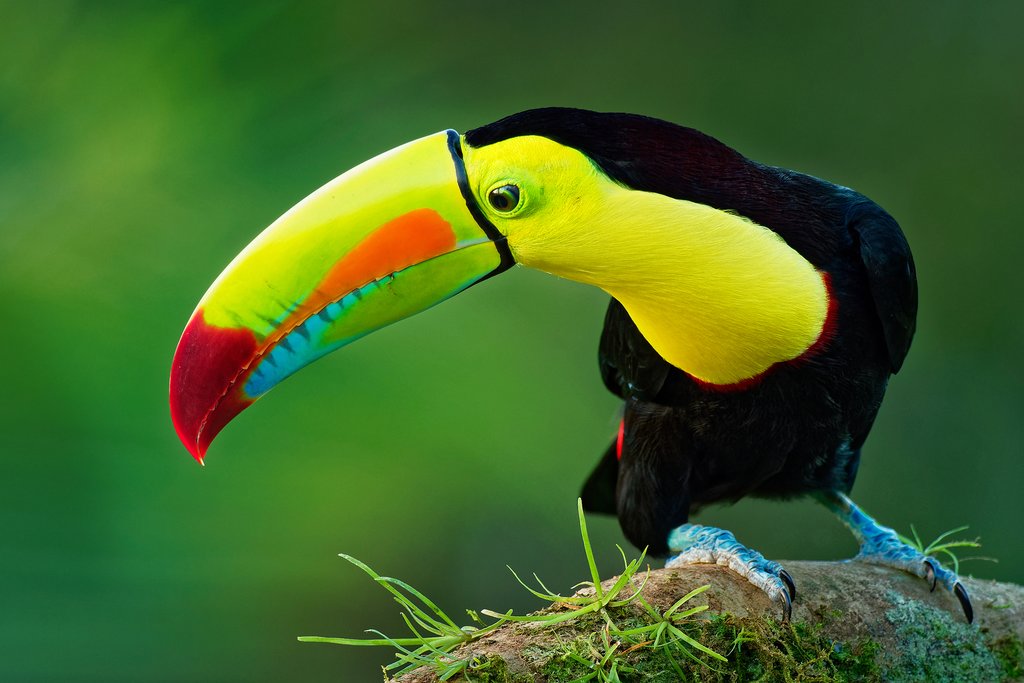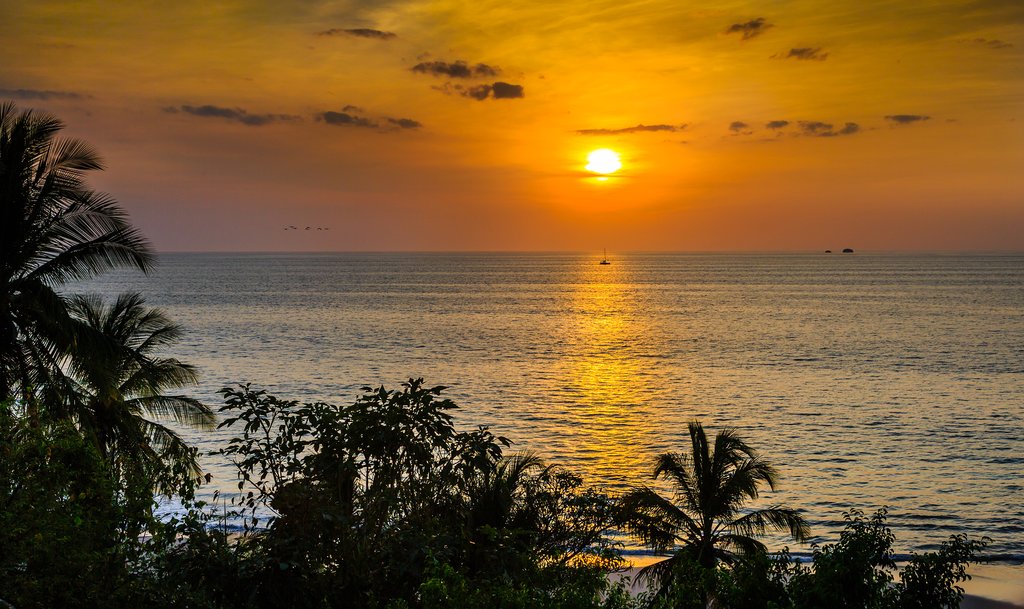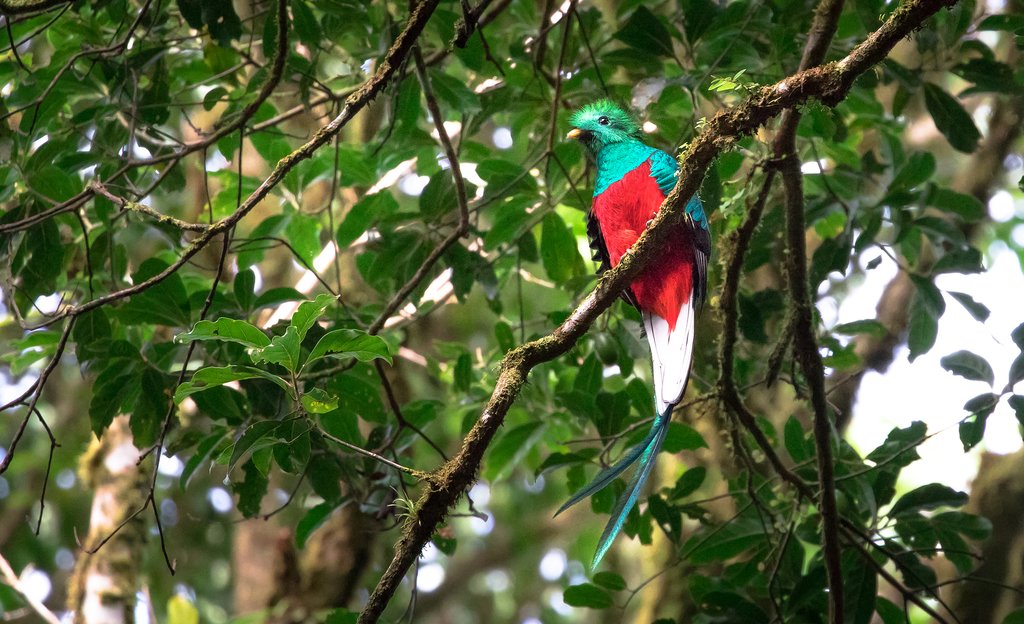Highlights
- Hike along rainforest trails and view exotic bird species like macaws and toucans
- Go on early-morning birding adventures to see exotic birds at their most active
- Visit world-famous biological research stations that study tropical ecosystems
- View the elusive resplendent quetzal in its natural habitat
- Enjoy birdwatching on the Pacific coast and visit havens for scarlet macaws
Brief Itinerary
| Day | Highlights | Overnight |
|---|---|---|
| Day 1 | Arrival in Costa Rica – Experience San José's Culture | San Jose |
| Day 2 | Transfer From San José to Boca Tapada | Boca Tapada |
| Day 3 | Birding at Boca Tapada | Boca Tapada |
| Day 4 | Drive from Boca Tapada to Sarapiquí | Sarapiquí |
| Day 5 | Morning Birding - Transfer to the Turrialba Valley | Turrialba |
| Day 6 | Drive to the Talamanca Mountains | San Gerardo de Dota |
| Day 7 | Quetzal Safari in Los Quetzales National Park | San Gerardo de Dota |
| Day 8 | Transfer to Puntarenas Province | Las Cruces |
| Day 9 | Drive to Piedras Blancas | La Gamba |
| Day 10 | Early Birding on the Southern Pacific Coast | La Gamba |
| Day 11 | Transfer to Tárcoles | Tarcoles |
| Day 12 | Morning Birding - Carara National Park | Tarcoles |
| Day 13 | Transfer to the Airport - Departure |
Detailed Itinerary
Day 1: Arrival in Costa Rica – Experience San José's Culture

Welcome to Costa Rica, the land of pura vida! After arriving at Juan Santamaría International Airport in San José, a local representative will meet you and escort you to your hotel. The rest of the day you'll have free to explore the city at your leisure.
Perhaps stroll through Mercado Central (Central Market), which features over 200 shops and food stalls. Then visit the Catedral Metropolitana (Metropolitan Church), whose interior combines Greek Orthodox, neoclassical, and Baroque styles. There's also the neo-classical National Theater and the Museo del Jade, which houses the world's largest collection of pre-Columbian jade artifacts.
Be sure to explore Barrio Amón, a bohemian neighborhood home to historic cafetalero (coffee grower) mansions built during the late 19th and early 20th centuries. For dinner, opt for a restaurant in the hills of Escazú. This elevated region on the western edge of the city offers panoramic views of the valley below. That said, San José is filled with great restaurants serving everything from traditional Costa Rican fare to forward-thinking fusion cuisine.
Day 2: Transfer From San José to Boca Tapada

Wake up and enjoy breakfast at your hotel. You'll then hop in your rental car and begin the drive north towards the Nicaraguan border. This is a scenic trip that passes by the rainforest-covered mountains of the Central Valley before reaching Costa Rica's northern plains.
When lunchtime rolls around, do like the locals and pull off at one of the many roadside "sodas." These family-run eateries are the life-blood of the country and serve delicious homemade fare. Typical options include the casado, a combo plate featuring rice, beans, and your choice of chicken, beef, pork, or fish.
Your drive continues to the Boca Tapada region, situated on the San Carlos River just a few kilometers south of the Nicaraguan border. This bucolic area is far off the tourist trail and offers secluded nature and a number of excursions, such as boat rides on the river and, of course, great birding.
You'll be staying at a local eco-lodge in the rainforest that sits on almost 150 acres and is home to over 410 bird species. This makes for ideal conditions for nature photography, and it's the perfect spot for a birding excursion. There are even bird feeders in the gardens around the lodge, so you don't have to travel far to view some of the most exotic species.
Day 3: Birding at Boca Tapada

Today's birding adventure starts early, at 5:30 am, when most of the birds in the area are waking up and beginning their daily routine. Along with a naturalist guide, you'll hike through the rainforest in search of both native and migratory species. Types of birds you can spot include the green macaw, scarlet macaw, toucans, oropendolas, honeycreepers, tanagers, euphonias, and jacamars.
You'll return to your ecolodge at 7:30 am to enjoy a delicious breakfast. As a bonus, you'll be able to see hummingbirds, woodpeckers, parrots, and toucans, fluttering right near the restaurant terrace as you eat. Next up is a brisk rainforest hike in which a knowledgable local guide reveals even more secrets about the jungle. Afterward, if you still have the energy, you can opt for an afternoon boat ride on the San Carlos River to observe more wildlife while floating down to the Nicaraguan border.
Day 4: Drive from Boca Tapada to Sarapiquí

In the morning you'll embark on a 1.5-hour drive east to the Sarapiqui region. It is known throughout Costa Rica for its rich biodiversity and thus is a prime destination for nature seekers. Upon arrival in town, you'll continue a short distance to your hotel and check-in. After that, you will have the afternoon at leisure to explore the surroundings. If you're up for some wildlife spotting, there are a number of sites within easy hiking distance.
At the La Tirimbina Rainforest Center, you can enjoy a self-guided hike along the nature trails within this 850-acre biological reserve. Their five miles of hiking trails pass through mid-elevation premontane forest and include hiking on suspension bridges that cross over the Sarapiquí River. A walk here is filled with unique rainforest vegetation as well as different species of wildlife and exotic birds.
Later you can opt for a visit to Selva Verde, a lodge nestled within a 500-acre private reserve. In the evening, you'll have the option to join one of Selva Verde's on-site naturalists for a nocturnal nature tour, and they will point out exotic species like tree frogs, stick insects, kinkajous, bats, and spiders.
Day 5: Morning Birding - Transfer to the Turrialba Valley

Another fantastic day is in store as you awake early for a drive to La Tirimbina Rainforest Center for a morning birdwatching tour. Over the course of 2.5 hours, a local English-speaking guide will share their knowledge about the region and its wildlife as you hike along the river to primary and secondary forests in search of different species. Some of the birds you'll see are tanagers, honeycreepers, and herons. Other rare species include the sunbittern, snowy cotinga, collared aracari, and black-crested coquette.
Afterward, you'll return the hotel for breakfast and then embark on a three-hour drive to Turrialba. Conveniently located between San José and the Caribbean coast, this region is known for its green rolling hills and volcano of the same name. Turrialba´s rich volcanic soil is ideal for the growth of coffee, sugar cane, macadamia, and other crops. It's also famous for cheesemaking and open-air fruit and vegetable markets that offer some of the best produce in Costa Rica.
Your destination in Turrialba is a family-owned lodge on a 140-acre reserve. The main building is done in the Spanish-colonial style, and there's a large indoor/outdoor dining area offering great birding vantage points while you eat. The lodge also features a premier birding viewpoint upstairs in the ranch's main building.
Chat with a local specialist who can help organize your trip.
Day 6: Drive to the Talamanca Mountains

In the morning you'll continue your adventure with a 3.5-hour drive from Turrialba deep into the heart of the Talamanca Mountains and the community of San Gerardo de Dota. You can stop along the way for an optional visit to the highest active volcano in Costa Rica, the Irazu Volcano (11,259 feet3,432 meters). On this break from the road, you'll stroll the various hiking trails and can peer into the volcano's three volcanic craters. One of them even has an impressive turquoise lagoon in it.
Afterward, you'll continue the drive southeast of San José to the city of Cartago, where you can visit the most famous church in the country, the Nuestra Señora de los Ángeles Basilica, and In the late afternoon, you'll reach San Gerardo de Dota. Enjoy the cool mist in this high-altitude valley surrounded by cloud forests brimming with oak trees. It's this unique forest that's the habitat of one of the most beautiful birds in the world, the resplendent quetzal.
After checking into your mountain hotel, you can spend the rest of the day relaxing. The hotel is remote, so we recommend enjoying dinner at its stellar restaurant. Be sure to sleep well and save energy because tomorrow we will look for the resplendent quetzal.
Day 7: Quetzal Safari in Los Quetzales National Park

The small town of San Gerardo de Dota sits next to a quiet road in the Talamanca Mountains. The main attraction here is Los Quetzales National Park, famous among birding enthusiasts as one of the best places to view the resplendent quetzal. With its vivid green and red plumage, it has an earned reputation as one of the world's most beautiful birds.
In the morning you'll embark on an early (5 am) birding tour in search of the resplendent quetzal. You stand a good chance of spotting one, as the cool climate in this higher-altitude region is attractive to the quetzal, as are the berries produced by the many aguacatillo trees here. With its metallic green plumage, crimson breast, and long, flowing tail feathers, watching a quetzal soar through the air is a unique and breathtaking experience.
After the tour, you'll go back to your hotel for breakfast, and then you'll have the rest of the day free. You can choose between a number of leisure activities, be it hiking the trails around the hotel, lazing by the pool, or simply relaxing on the restaurant patio and looking for more birds.
Day 8: Transfer to Puntarenas Province

Wake up early, because today you have a four-hour drive waiting for you. This road trip will take you from the highlands of the country south along Ruta 2 to San Isidro del General. The town is centered around a lovely square with a landscaped park and large church. The highlight is a weekly farmers market with over 200 vendors selling every kind of fruit and vegetable you can imagine plus prepared foods and artisanal products.
After a short break in town, you'll continue the drive to a biological research station located in Puntarenas Province. It's a nature reserve and research center encompassing 657 acres of unspoiled forest, which is home to over 400 species of birds, 100 species of mammals, and over 800 species of butterflies. Also within the station is a botanical garden which features hundreds of different plants from around the world in a 30-acre site.
Day 9: Drive to Piedras Blancas

For your last morning at the biological station, you can embark on an optional two-hour birding tour accompanied by a local guide. If you don't want to travel far, you can stay close to the station. Feeders near the dining hall offer chances to see the scarlet-thighed dacnis, blue-crowned motmot, and various tanagers. After the tour, you'll enjoy breakfast at the lodge.
Upon checking out of your hotel, you'll embark on an hour drive west to a rainforest lodge located near Piedras Blancas National Park. Hidden away in the jungle, it's a hotspot for birders and nature lovers wishing to experience a remote rainforest environment undisturbed by mass tourism. The lodge offers a variety of tours and excursions including to the nearby Osa Peninsula and Corcovado National Park. Other activities include hiking, horseback riding, and kayaking off the coast.
Day 10: Early Birding on the Southern Pacific Coast

Another great birding tour awaits in the form of a two-hour hike. With an experienced guide, you'll travel the forest trails in the Golfo Dulce region. There are many exotic species in the area, including trogons, motmots, woodpeckers, manakins, curassows, and the famous black-cheeked ant tanager. Animals sighted around the trails include agoutis, coatis, and caimans. The hike departs around 6 am and returns in time for breakfast. You can then spend the remainder of the day on optional nature excursions.
Day 11: Transfer to Tárcoles

Today you'll hop in your rental car and make the drive north to the central Pacific coast and the village of Tárcoles. Located within Carara National Park, Tárcoles is known for its colorful macaws as well as the giant crocodiles that congregate on the banks of the adjacent Tárcoles River.
After checking into your eco-lodge, you'll be able to go on a birding excursion with a private guide. There are always interesting species on hand, like the chestnut-mandibled toucan, fiery-billed aracari, pale-billed woodpecker, and various types of trogons (slaty-tailed, gartered, black-headed, etc.). Plus, groups of scarlet macaws often fly overhead, especially in the early morning and late afternoon.
The forest trails in this region are worth a visit because there's a good chance of spotting the long-tailed manakin, a colorful bird known for performing choreographed dances to attract females. You can also spot the black-faced antthrush and other interesting species.
Day 12: Morning Birding - Carara National Park

Accompanied by your guide, you'll embark on a birding tour along the trails around your eco-lodge. There are always interesting species on hand, like the chestnut-mandibled toucan, fiery-billed aracari, pale-billed woodpecker, and various types of trogons (slaty-tailed, gartered, black-headed, etc.). Plus, groups of scarlet macaws often fly overhead, especially in the early morning and late afternoon.
The small forest trail right behind the hotel is also worth a visit because there's a good chance of spotting the long-tailed manakin, a colorful bird known for performing choreographed dances to attract females. More than the manakin, this trail affords opportunities to spot the black-faced antthrush and other interesting species.
After the tour, you'll have the rest of the day free to explore. We recommend visiting Carara National Park. This protected area encompasses 12,900 acres and includes both tropical dry scrub and southern Pacific rainforest, which makes it home to a wide variety of flora and fauna. Some 360 of birds call this area home, most famously the scarlet macaw. Travelers come from far and wide to see the largest remaining wild population of these birds in the country.
Day 13: Transfer to the Airport - Departure

After enjoying a leisurely breakfast at your hotel, you'll make the drive back to San José and Juan Santamaría International Airport. You'll then drop off your vehicle at the car rental service and transfer to the terminal to catch your flight home. We wish you a safe flight and hope to greet in Costa Rica again soon. Hasta luego and pura vida!


